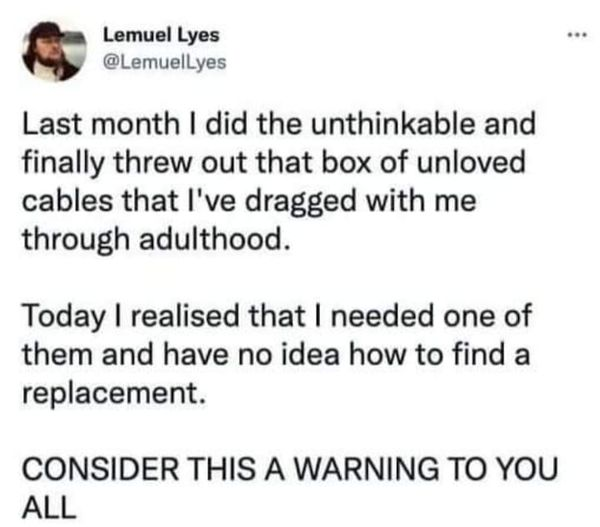this post was submitted on 20 Aug 2024
2207 points (99.3% liked)
Microblog Memes
6184 readers
2884 users here now
A place to share screenshots of Microblog posts, whether from Mastodon, tumblr, ~~Twitter~~ X, KBin, Threads or elsewhere.
Created as an evolution of White People Twitter and other tweet-capture subreddits.
Rules:
- Please put at least one word relevant to the post in the post title.
- Be nice.
- No advertising, brand promotion or guerilla marketing.
- Posters are encouraged to link to the toot or tweet etc in the description of posts.
Related communities:
founded 2 years ago
MODERATORS
you are viewing a single comment's thread
view the rest of the comments
view the rest of the comments

Oh I never of this. So do you have different electrical systems in your house for each voltage or how does it work?
I am off-grid for much of the time so I rely on an entirely DC to DC system. 200 watts of solar panels power up my batteries which supply 12V at a capacity of about 400 watt hours. So for many appliances like laptops and speakers and computer screens which use DC power it makes sense to try to convert the voltages directly though other means than the typical AC to DC power plug supplies that you usually use in homes. Doing this I can cut down total power consumption for each device down by about half which is really important for conserving power on a limited energy supply.
In a theoretical scenario you could totally run a seperate voltage line for DC energy through a house, though this has several complications. The main drawback of DC energy is that the lower the voltage the more resistance losses you get running power through a foot of cable. So the cable losses would become signifigant after running 200 feet of cable probably less even. You could bump up the voltage to 48VDC for longer stretches of wire and to power high end RV appliances but now were loosing some of the safety that comes from a lower voltage DC system. Im not familiar with commercial solar installations in homes but I think its easier and more economical to eat inverter losses and use the batteries to supply AC power using preexisting wiring. If you were building a offgrid home its a design thing to consider, reducing and centralizing wiring and appliances.
But then what are you doing? Are you connecting your laptop directly to the battery with shorter cables?
Thank you for taking the time to reply, this is very interesting.
I have my portable folding 200w solar panels on the ground and run about 20ft of weatherproof cabling running along the ground through a small inlet hole into my residence. They connect to my battery system which is located in a good central spot for all my electrical stuff to comfortably reach. Everything I own that runs on electrical power that cant be powered with portable rechargable battery banks is located in the same room as my batteries.
I can deliver DC power through car plug ports, USBC-PD 100W and regular usb A outlets. The 600w AC inverter is useful for brewing cups of coffee, running fans, and turning on a desktop pc for advanced GPU workload stuff. Its important to keep that ac inverter off most of the time especially at night so prefer using car plug adapters and USBC-PD to directly power most of my DC appliances with variable voltages instead. From the car plugs and usbc-pd charger ports, I run my dc appliance cords to my devices which are usually 6-10 ft long. My laptop is usually powered up through a car port travel adapter but I can also use USBC-PD and an adapter bit if the car ports are all taken up.
Thank you for showing interest if you want to know anything else ill be happy to explain. lowtechmagazine's "Slow Electricity: The Return of DC Power" is a great read on the subject the info has been very useful for my purposes. They cover residential dc wiring like we are talking about and its located around the end of the article in the 'How To Limit Cable Losses' section.